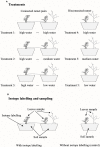Plant Clonal Integration Mediates the Horizontal Redistribution of Soil Resources, Benefiting Neighboring Plants
- PMID: 26904051
- PMCID: PMC4742616
- DOI: 10.3389/fpls.2016.00077
Plant Clonal Integration Mediates the Horizontal Redistribution of Soil Resources, Benefiting Neighboring Plants
Abstract
Resources such as water taken up by plants can be released into soils through hydraulic redistribution and can also be translocated by clonal integration within a plant clonal network. We hypothesized that the resources from one (donor) microsite could be translocated within a clonal network, released into different (recipient) microsites and subsequently used by neighbor plants in the recipient microsite. To test these hypotheses, we conducted two experiments in which connected and disconnected ramet pairs of Potentilla anserina were grown under both homogeneous and heterogeneous water regimes, with seedlings of Artemisia ordosica as neighbors. The isotopes [(15)N] and deuterium were used to trace the translocation of nitrogen and water, respectively, within the clonal network. The water and nitrogen taken up by P. anserina ramets in the donor microsite were translocated into the connected ramets in the recipient microsites. Most notably, portions of the translocated water and nitrogen were released into the recipient microsite and were used by the neighboring A. ordosica, which increased growth of the neighboring A. ordosica significantly. Therefore, our hypotheses were supported, and plant clonal integration mediated the horizontal hydraulic redistribution of resources, thus benefiting neighboring plants. Such a plant clonal integration-mediated resource redistribution in horizontal space may have substantial effects on the interspecific relations and composition of the community and consequently on ecosystem processes.
Keywords: Potentilla anserina; [15N]; clonal integration; deuterium; environmental heterogeneity; hydraulic redistribution; stable isotope.
Figures



Similar articles
-
Ecological Consequences of Clonal Integration in Plants.Front Plant Sci. 2016 Jun 30;7:770. doi: 10.3389/fpls.2016.00770. eCollection 2016. Front Plant Sci. 2016. PMID: 27446093 Free PMC article. Review.
-
The interaction between water and nitrogen translocation in a rhizomatous sedge (Carex flacca).Oecologia. 1998 Aug;116(1-2):38-49. doi: 10.1007/s004420050561. Oecologia. 1998. PMID: 28308539
-
Nutrient addition increases the capacity for division of labor and the benefits of clonal integration in an invasive plant.Sci Total Environ. 2018 Dec 1;643:1232-1238. doi: 10.1016/j.scitotenv.2018.06.294. Epub 2018 Jul 4. Sci Total Environ. 2018. PMID: 30189539
-
Partial mechanical stimulation facilitates the growth of the rhizomatous plant Leymus secalinus: modulation by clonal integration.Ann Bot. 2011 Apr;107(4):693-7. doi: 10.1093/aob/mcr012. Epub 2011 Feb 7. Ann Bot. 2011. PMID: 21303785 Free PMC article.
-
Plant traits and ecosystem effects of clonality: a new research agenda.Ann Bot. 2014 Aug;114(2):369-76. doi: 10.1093/aob/mcu113. Epub 2014 Jun 19. Ann Bot. 2014. PMID: 24948670 Free PMC article. Review.
Cited by
-
Facilitation by a Spiny Shrub on a Rhizomatous Clonal Herbaceous in Thicketization-Grassland in Northern China: Increased Soil Resources or Shelter from Herbivores.Front Plant Sci. 2017 May 16;8:809. doi: 10.3389/fpls.2017.00809. eCollection 2017. Front Plant Sci. 2017. PMID: 28559913 Free PMC article.
-
Ecological Consequences of Clonal Integration in Plants.Front Plant Sci. 2016 Jun 30;7:770. doi: 10.3389/fpls.2016.00770. eCollection 2016. Front Plant Sci. 2016. PMID: 27446093 Free PMC article. Review.
-
Impacts of Sand Burial and Wind Erosion on Regeneration and Growth of a Desert Clonal Shrub.Front Plant Sci. 2018 Dec 11;9:1696. doi: 10.3389/fpls.2018.01696. eCollection 2018. Front Plant Sci. 2018. PMID: 30619381 Free PMC article.
-
An assessment of diurnal water uptake in a mesic prairie: evidence for hydraulic lift?Oecologia. 2017 Apr;183(4):963-975. doi: 10.1007/s00442-017-3827-2. Epub 2017 Feb 2. Oecologia. 2017. PMID: 28154965
References
-
- Burgess S. S. O. (2011). Can hydraulic redistribution put bread on our table? Plant Soil 341 25–29. 10.1007/s11104-010-0638-1 - DOI
LinkOut - more resources
Full Text Sources
Other Literature Sources

